Review Questions - Click On The Picture To Begin...
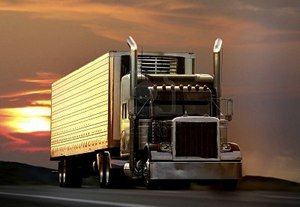
- Controls the emergency brakes
- Supplies air to the trailer air tanks
- Controls the parking brakes
- Carries air controlled by the foot brake or the trailer hand brake
Quote From The CDL Manual:
The service line (also called the "control line" or "signal line") carries air controlled by the foot brake or the trailer hand brake. Depending on how hard you press the foot brake or hand valve, the pressure in the service line will similarly change. The service line is connected to relay valves. These valves allow the trailer brakes to be applied more quickly than would otherwise be possible.
- Blue
- Green
- Black
- Red
Quote From The CDL Manual:
Emergency lines are often coded with the color red (red hose, red couplers or other parts) to keep from getting them mixed up with the blue service line.
TruckingTruth's Advice:
While the emergency line will almost always be red, the color is not a regulation so some trucks may use other colors.
- Orange
- Blue
- Green
- Red
Quote From The CDL Manual:
Emergency lines are often coded with the color red (red hose, red couplers or other parts) to keep from getting them mixed up with the blue service line.
TruckingTruth's Advice:
While not an actual regulation, the normal color scheme is usually as follows:
- Emergency Line: Red
- Service Line: Blue
- Electrical Line: Green
Again, these are not actual regulations so colors may vary from truck to truck, but these colors have become the industry norm.
- The yellow "parking brake" control valve
- The trailer hand valve
- The red "trailer air supply" control valve
- The brake pedal
Quote From The CDL Manual:
The tractor protection valve keeps air in the tractor or truck should the trailer break away or develop a bad leak. The tractor protection valve is controlled by the "trailer air supply" control valve in the cab. The control valve allows you to open and shut the tractor protection valve. The tractor protection valve will close automatically if air pressure is low (in the range of 20 to 45 psi). When the tractor protection valve closes, it stops any air from going out of the tractor. It also lets the air out of the trailer emergency line. This causes the trailer emergency brakes to come on.
- Red Line and Blue Line
- Primary Line and Secondary Line
- Service Line and Emergency Line
- Parent Line and Child Line
Quote From The CDL Manual:
Every combination vehicle has two air lines: the service line and the emergency line. They run between each vehicle (tractor to trailer, trailer to dolly, dolly to second trailer, etc.).
TruckingTruth's Advice:
Be sure you understand the difference between the Service Air Line and the Emergency Air Line.
- The Service Air Line controls the service brakes when you use the brake pedal.
- The Emergency Air Line supplies air to the trailer air tanks and the emergency brakes.
- 0 to 20 psi
- 100 to 125 psi
- 50 to 70 psi
- 20 to 45 psi
Quote From The CDL Manual:
The trailer air supply control on newer vehicles is a red 8-sided knob used to control the tractor protection valve. Push it in to supply the trailer with air, and pull it out to shut the air off and put on the trailer emergency brakes. The valve will pop out, thus closing the tractor protection valve, when the air pressure drops into the range 20 to 45 psi. Tractor protection valve controls or "emergency" valves on older vehicles may not operate automatically. There may be a lever rather than a knob. The "normal" position is used for pulling a trailer. The "emergency" position is used to shut the air off and put on the trailer emergency brakes.
- A lever which only controls the trailer service brakes
- A valve used to release the air lines from the tractor to the trailer
- The trailer release mechanism
- A lever which only controls the tractor service brakes
Quote From The CDL Manual:
The trailer hand valve (also called the "trolley valve" or "Johnson bar") works the trailer brakes. The trailer hand valve should be used only to test the trailer brakes. Do not use it in driving because of the danger of making the trailer skid. The foot brake sends air to all the brakes on the vehicle (including the trailer(s'). There is much less danger of causing a skid or jackknife when using just the foot brake.
Never use the hand valve for parking because all the air might leak out, unlocking the brakes (in trailers that do not have spring brakes.) Always use the parking brakes when parking. If the trailer does not have spring brakes, use wheel chocks to keep the trailer from moving.
- 50 to 75 psi
- 20 to 45 psi
- 0 to 25 psi
- 90 to 110 psi
Quote From The CDL Manual:
The tractor protection valve will close automatically if air pressure is low (in the range of 20 to 45 psi).
TruckingTruth's Advice:
It is definitely worth memorizing the psi range the tractor protection valve will automatically close. Not only will you need to know this for the written and pre-trip exams, but you'll definitely want to know this info for real-world driving situations and when testing the air brake system.
- Activates the air compressor located on the trailer
- Supplies the trailer with air from the tractor
- Controls the parking brake on the tractor
- Supplies the tractor with air from the trailer
Quote From The CDL Manual:
The trailer air supply control on newer vehicles is a red 8-sided knob used to control the tractor protection valve. Push it in to supply the trailer with air, and pull it out to shut the air off and put on the trailer emergency brakes. The valve will pop out, thus closing the tractor protection valve, when the air pressure drops into the range 20 to 45 psi. Tractor protection valve controls or "emergency" valves on older vehicles may not operate automatically. There may be a lever rather than a knob. The "normal" position is used for pulling a trailer. The "emergency" position is used to shut the air off and put on the trailer emergency brakes.
- It can throw your brakes out of adjustment
- There is an increased danger of making the trailer skid
- You may wear out the tractor brakes more quickly
- It only applies braking force to the tractor brakes
Quote From The CDL Manual:
The trailer hand valve should be used only to test the trailer brakes. Do not use it in driving because of the danger of making the trailer skid. The foot brake sends air to all the brakes on the vehicle (including the trailer(s'). There is much less danger of causing a skid or jackknife when using just the foot brake.
- It is only used to test the trailer service brakes
- During long or steep declines, the trailer hand valve should be used to protect against tractor brake fade
- Can be used in place of the parking brake
- Should be used to recover a trailer that has begun to jackknife
Quote From The CDL Manual:
The trailer hand valve (also called the "trolley valve" or "Johnson bar") works the trailer brakes. The trailer hand valve should be used only to test the trailer brakes. Do not use it in driving because of the danger of making the trailer skid. The foot brake sends air to all the brakes on the vehicle (including the trailer(s'). There is much less danger of causing a skid or jackknife when using just the foot brake.
Never use the hand valve for parking because all the air might leak out, unlocking the brakes (in trailers that do not have spring brakes.) Always use the parking brakes when parking. If the trailer does not have spring brakes, use wheel chocks to keep the trailer from moving.
TruckingTruth's Advice:
Many trucks no longer come with a trailer hand valve, but if your truck has one, you should use it only for testing the trailer service brakes and nothing more.
- It carries air controlled by the foot brake or trailer hand brake
- When the line loses air pressure, it causes the tractor protection valve to close
- It supplies air to the trailer air tanks
- It controls the emergency brakes on combination vehicles
Quote From The CDL Manual:
The emergency line (also called the supply line) has two purposes:
- (1) To supply air to the trailer air tanks
- (2) to control the emergency brakes on combination vehicles.
Loss of air pressure in the emergency line causes the trailer emergency brakes to come on. The pressure loss could be caused by a trailer breaking loose, thus tearing apart the emergency air hose. Or it could be caused by a hose, metal tubing or other part that breaks, letting the air out. When the emergency line loses pressure, it also causes the tractor protection valve to close (the air supply knob will pop out).
- A lever on the side of the steering wheel used to control the trailer hand valve
- A yellow diamond shaped knob used to control the tractor parking brake
- There is no control for the trailer air supply on newer vehicles as it's all done automatically
- A red 8-sided knob used to control the tractor protection valve
Quote From The CDL Manual:
The trailer air supply control on newer vehicles is a red 8-sided knob used to control the tractor protection valve. Push it in to supply the trailer with air, and pull it out to shut the air off and put on the trailer emergency brakes. The valve will pop out, thus closing the tractor protection valve, when the air pressure drops into the range 20 to 45 psi. Tractor protection valve controls or "emergency" valves on older vehicles may not operate automatically. There may be a lever rather than a knob. The "normal" position is used for pulling a trailer. The "emergency" position is used to shut the air off and put on the trailer emergency brakes.
- Lets the air out of the trailer emergency line, causing the trailer emergency brakes to come on
- Keeps air in the tractor or truck should the trailer break away or develop a bad leak
- When the valve closes, it stops any air from going out of the tractor
- All of these are functions of the Tractor Protection Valve
Quote From The CDL Manual:
The tractor protection valve keeps air in the tractor or truck should the trailer break away or develop a bad leak. The tractor protection valve is controlled by the "trailer air supply" control valve in the cab. The control valve allows you to open and shut the tractor protection valve. The tractor protection valve will close automatically if air pressure is low (in the range of 20 to 45 psi). When the tractor protection valve closes, it stops any air from going out of the tractor. It also lets the air out of the trailer emergency line. This causes the trailer emergency brakes to come on.



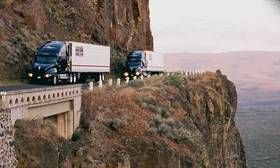
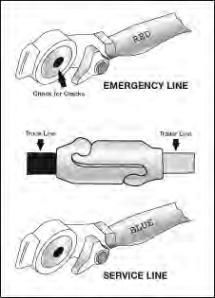

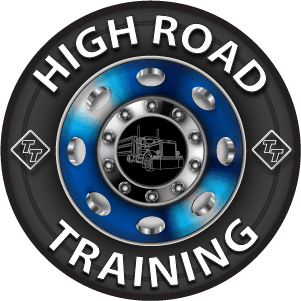

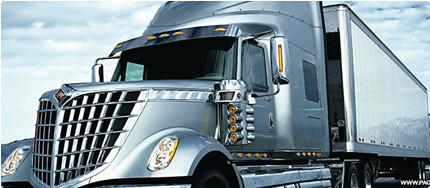
 TT On Facebook
TT On Facebook